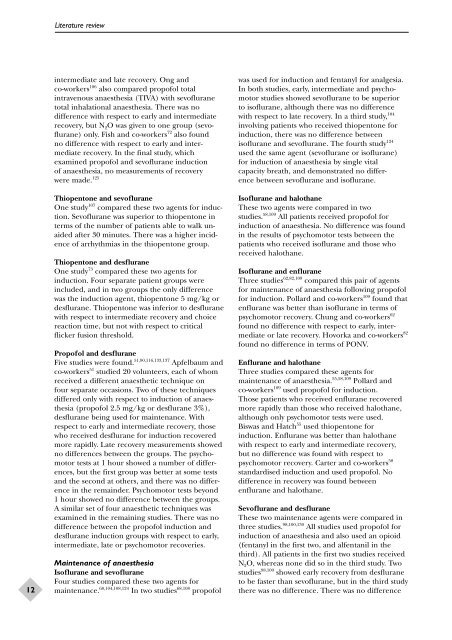Aanesthetic Agents for Day Surgery - NIHR Health Technology ...
Aanesthetic Agents for Day Surgery - NIHR Health Technology ...
Aanesthetic Agents for Day Surgery - NIHR Health Technology ...
Create successful ePaper yourself
Turn your PDF publications into a flip-book with our unique Google optimized e-Paper software.
12<br />
Literature review<br />
intermediate and late recovery. Ong and<br />
co-workers 106 also compared propofol total<br />
intravenous anaesthesia (TIVA) with sevoflurane<br />
total inhalational anaesthesia. There was no<br />
difference with respect to early and intermediate<br />
recovery, but N 2O was given to one group (sevoflurane)<br />
only. Fish and co-workers 72 also found<br />
no difference with respect to early and intermediate<br />
recovery. In the final study, which<br />
examined propofol and sevoflurane induction<br />
of anaesthesia, no measurements of recovery<br />
were made. 125<br />
Thiopentone and sevoflurane<br />
One study 107 compared these two agents <strong>for</strong> induction.<br />
Sevoflurane was superior to thiopentone in<br />
terms of the number of patients able to walk unaided<br />
after 30 minutes. There was a higher incidence<br />
of arrhythmias in the thiopentone group.<br />
Thiopentone and desflurane<br />
One study 73 compared these two agents <strong>for</strong><br />
induction. Four separate patient groups were<br />
included, and in two groups the only difference<br />
was the induction agent, thiopentone 5 mg/kg or<br />
desflurane. Thiopentone was inferior to desflurane<br />
with respect to intermediate recovery and choice<br />
reaction time, but not with respect to critical<br />
flicker fusion threshold.<br />
Propofol and desflurane<br />
Five studies were found. 51,90,116,133,137 Apfelbaum and<br />
co-workers 51 studied 20 volunteers, each of whom<br />
received a different anaesthetic technique on<br />
four separate occasions. Two of these techniques<br />
differed only with respect to induction of anaesthesia<br />
(propofol 2.5 mg/kg or desflurane 3%),<br />
desflurane being used <strong>for</strong> maintenance. With<br />
respect to early and intermediate recovery, those<br />
who received desflurane <strong>for</strong> induction recovered<br />
more rapidly. Late recovery measurements showed<br />
no differences between the groups. The psychomotor<br />
tests at 1 hour showed a number of differences,<br />
but the first group was better at some tests<br />
and the second at others, and there was no difference<br />
in the remainder. Psychomotor tests beyond<br />
1 hour showed no difference between the groups.<br />
A similar set of four anaesthetic techniques was<br />
examined in the remaining studies. There was no<br />
difference between the propofol induction and<br />
desflurane induction groups with respect to early,<br />
intermediate, late or psychomotor recoveries.<br />
Maintenance of anaesthesia<br />
Isoflurane and sevoflurane<br />
Four studies compared these two agents <strong>for</strong><br />
maintenance. 68,104,108,124 In two studies 68,108 propofol<br />
was used <strong>for</strong> induction and fentanyl <strong>for</strong> analgesia.<br />
In both studies, early, intermediate and psychomotor<br />
studies showed sevoflurane to be superior<br />
to isoflurane, although there was no difference<br />
with respect to late recovery. In a third study, 104<br />
involving patients who received thiopentone <strong>for</strong><br />
induction, there was no difference between<br />
isoflurane and sevoflurane. The fourth study 124<br />
used the same agent (sevoflurane or isoflurane)<br />
<strong>for</strong> induction of anaesthesia by single vital<br />
capacity breath, and demonstrated no difference<br />
between sevoflurane and isoflurane.<br />
Isoflurane and halothane<br />
These two agents were compared in two<br />
studies. 58,109 All patients received propofol <strong>for</strong><br />
induction of anaesthesia. No difference was found<br />
in the results of psychomotor tests between the<br />
patients who received isoflurane and those who<br />
received halothane.<br />
Isoflurane and enflurane<br />
Three studies 62,82,109 compared this pair of agents<br />
<strong>for</strong> maintenance of anaesthesia following propofol<br />
<strong>for</strong> induction. Pollard and co-workers 109 found that<br />
enflurane was better than isoflurane in terms of<br />
psychomotor recovery. Chung and co-workers 62<br />
found no difference with respect to early, intermediate<br />
or late recovery. Hovorka and co-workers 82<br />
found no difference in terms of PONV.<br />
Enflurane and halothane<br />
Three studies compared these agents <strong>for</strong><br />
maintenance of anaesthesia. 55,58,109 Pollard and<br />
co-workers 109 used propofol <strong>for</strong> induction.<br />
Those patients who received enflurane recovered<br />
more rapidly than those who received halothane,<br />
although only psychomotor tests were used.<br />
Biswas and Hatch 55 used thiopentone <strong>for</strong><br />
induction. Enflurane was better than halothane<br />
with respect to early and intermediate recovery,<br />
but no difference was found with respect to<br />
psychomotor recovery. Carter and co-workers 58<br />
standardised induction and used propofol. No<br />
difference in recovery was found between<br />
enflurane and halothane.<br />
Sevoflurane and desflurane<br />
These two maintenance agents were compared in<br />
three studies. 98,100,130 All studies used propofol <strong>for</strong><br />
induction of anaesthesia and also used an opioid<br />
(fentanyl in the first two, and alfentanil in the<br />
third). All patients in the first two studies received<br />
N 2O, whereas none did so in the third study. Two<br />
studies 98,100 showed early recovery from desflurane<br />
to be faster than sevoflurane, but in the third study<br />
there was no difference. There was no difference
















